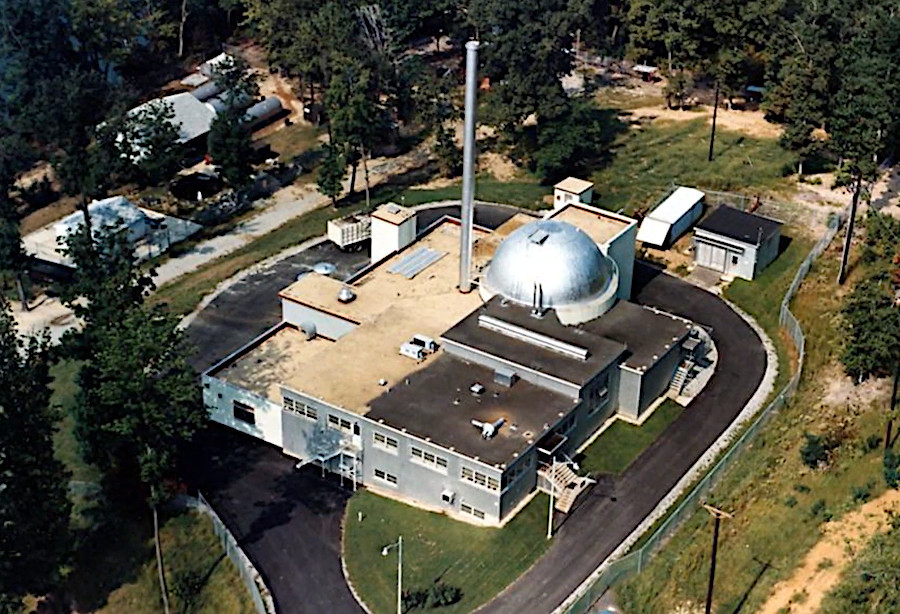
Virginia's first nuclear reactor, SM-1, was located under the containment dome at Fort Belvoir
Source: US Army Corps of Engineers, SM-1 Nuclear Power Plant

Virginia's first nuclear reactor, SM-1, was located under the containment dome at Fort Belvoir
Source: US Army Corps of Engineers, SM-1 Nuclear Power Plant
The Department of Defense gave the US Navy responsibility to develop nuclear propulsion systems for submarines and surface vessels, and the US Air Force managed nuclear warheads on ballistic missiles. The US Maritime Commission completed the only nuclear-powered commercial ship, the NS Savannah, in 1959.
The US Army was given responsibility for developing small nuclear power plants that could support land-based facilities for the Army, Navy and Air Force. The Army Nuclear Power Program was headquartered at Fort Belvoir, the home of the Corps of Engineers. The Corps tested two small nuclear power plants at Gunston Cove on the base. The SM-1 reactor was built on land, and the MH-1A reactor was installed in an old ship anchored initially in Gunston Cove.

the U.S. Army Engineer Reactors Group managed the Army Nuclear Power Program at Fort Belvoir
Source: Wikipedia, Army Nuclear Power Program
Both nuclear power plants relied upon fission from uranium enriched with the U-235 isotope to generate heat, which was used to pressurize water and spin a turbine. The nuclear fuel was unusual, but the turbine was a conventional design. It moved magnets inside coiled wires in order to generate electricity. Cooling water was provided by the Potomac River.
The first reactor was called the Army Package Power Reactor, then Stationary Medium Power Plant No. 1. The "S" in the code SM-1 indicated the reactor was Stationary, not Portable or Mobile. The "M" indicated it produced medium power (1 to 10 megawatts). The alternatives were Low (up to 1 megawatt) or High (over 10 megawatts) power. The "1" indicated it was the first of its design.1
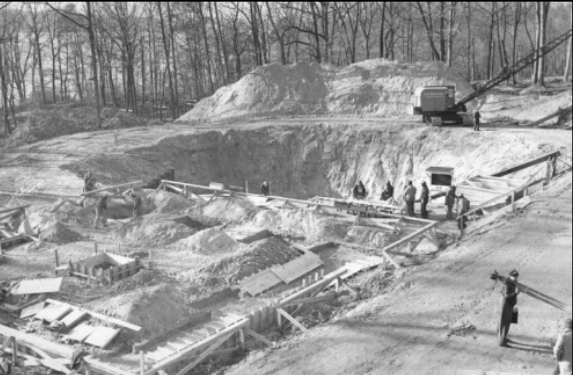
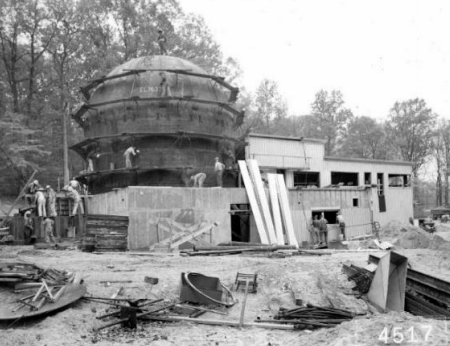
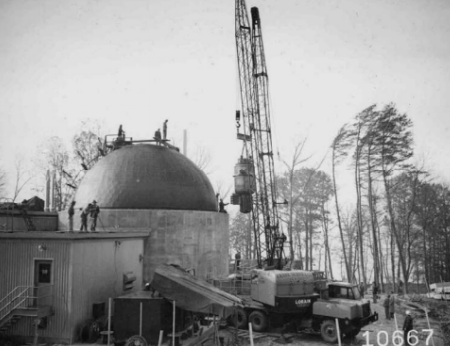
construction at Fort Belvoir for SM-1 in 1956
Source: US Army Corps of Engineers, SM-1 Deactivated Nuclear Power Plant Decommissioning Project
SM-1 was an early model of what the military expected to be many small, easy-to-deploy nuclear power plants built for deployment to locations without electricity. Research proposals for nuclear-powered aircraft and locomotives were also being explored at the time by groups outside the US military, and President Eisenhower was advancing his "Atoms for Peace" initiative.
The Corps of Engineers developed SM-1 with the encouragement of the Atomic Energy Commission, though the Army's reactors were not licensed by the Nuclear Regulatory Commission. The Oak Ridge National Laboratory designed the reactor, defining standard components that could be mass-produced and shipped to remote locations for installation as replacement parts.
The reactor was expected to operate for two years without a need for refueling. It operated from April 1957 to March 1973, and was refueled twice. The Department of Energy accepted the used fuel cores. The spent fuel from the original fuel core was shipped to the Idaho National Engineering and Environmental Laboratory. When the second and third cores were removed (the third core was removed at decommissioning), the spent fuel was shipped to the Savannah River Site.
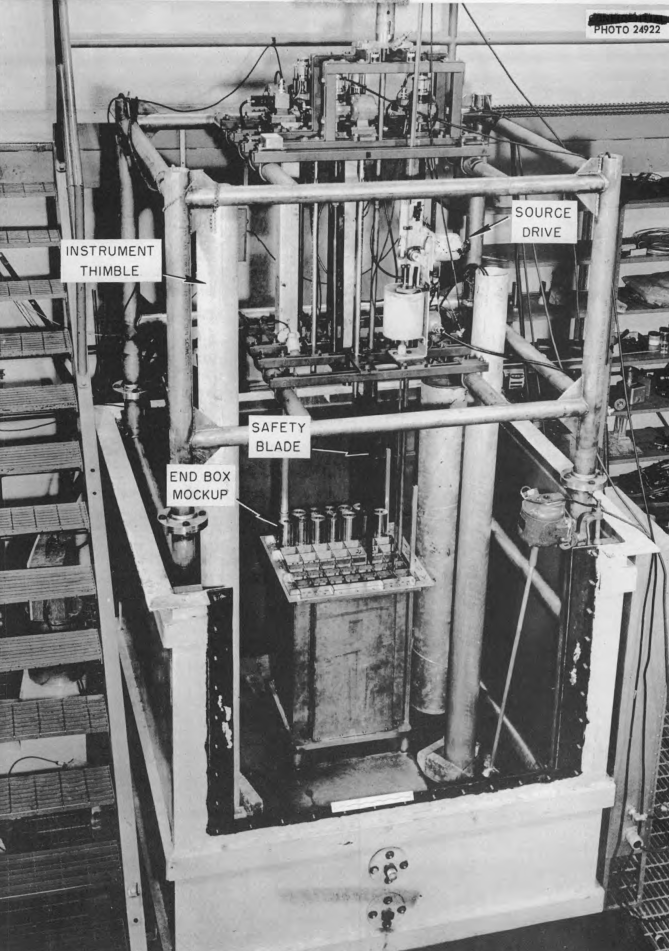
SM-1 was designed as a small package reactor, a precursor to modern Small Modular Reactor plans
Source: U.S. Department of Energy, Office of Scientific and Technical Information, Army Package Power Reactor, Critical Experiment (Figure 2)
The US Army did not build the reactor using military personnel or equipment. The reactor design was advertised for construction by private firms, using the design as the basis for bids. The Army received 18 bids, with the highest at $7 million.
Alco Products (American Locomotive Company) won the contract with a low bid of $2,096,753, and the company completed construction in 1957. Steam locomotives in the 1950's required construction of boilers with welds that could handle very high pressure. Alco had the technical expertise to build a pressurized-water reactor, one that used nuclear fuel instead of coal to generate heat.2
The 2-megawatt SM-1 was the first nuclear power plant to generate electricity in Virginia. It "went critical" on April 8, 1957, using highly enriched uranium as the power source. Later that month, the reactor became operational. The Army claims SM-1 was the first nuclear power station to be connected to an electrical grid; the commercial Shippingport Atomic Power Station in Pennsylvania went online nine months later.3
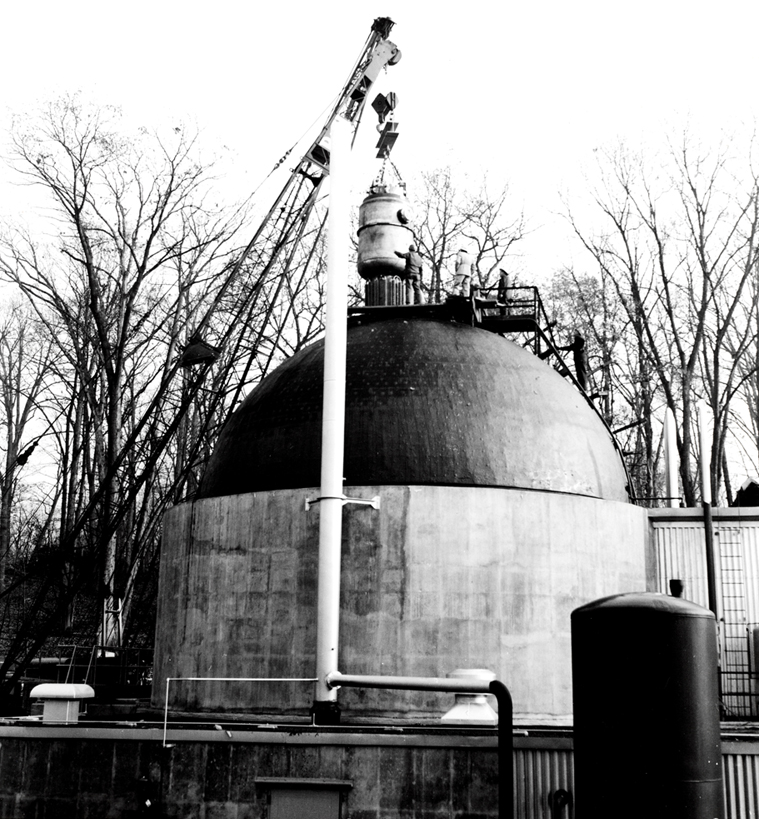
the SM-1 reactor components were lowered by crane into the building
Source: Army Engineer History, Nuclear Power at Fort Belvoir
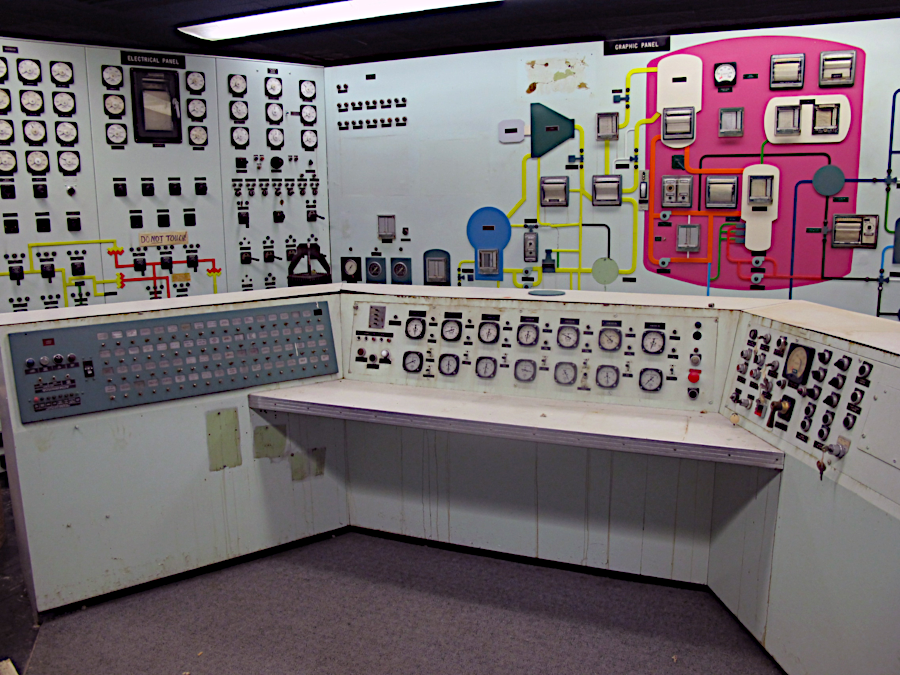
the control room of SM-1
Source: Army Engineer History, Nuclear Power at Fort Belvoir
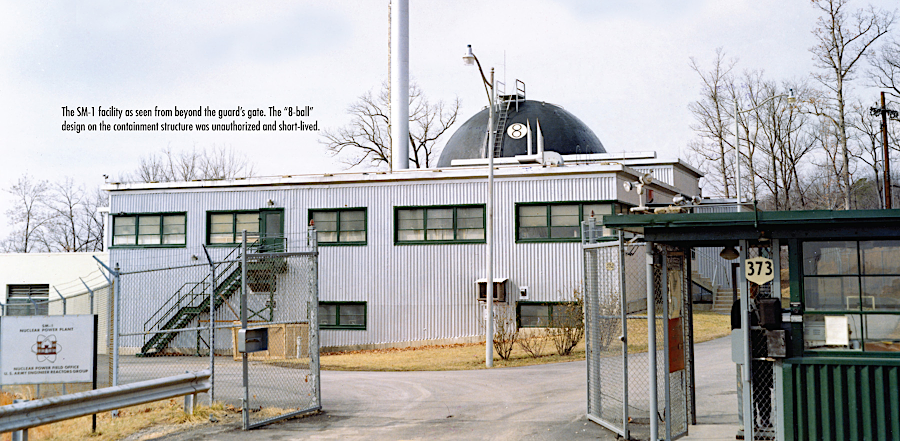
the 8-ball design was quickly removed
Source: US Army Corps of Engineers, Army Nuclear Power Program - SM-1 at Fort Belvoir
The reactor was designed as the solution for providing electricity at places that were not "on the grid" in an industrialized location. Hauling diesel fuel constantly to forward bases was expensive and, in a war zone, dangerous. Hauling a small reactor just once to a remote site was a safer, cost-effective alternative.
The US Army also explored the potential of using nuclear power to generate synthetic fuels at remote locations. Electricity was useful at static buildings, but trucks and tanks far away from supply bases still needed a fuel equivalent to diesel. The Army explored using a nuclear reactor to operate a heavy vehicle hauling cargo, and manufacturing synthetic fuel with electricity and/or steam from a reactor to manufacture synthetic fuels onsite and eliminate the need to drive tanker trucks through unsafe zones. At an energy depot, ammonia fuel could be generated from water and air and batteries could be recharged.
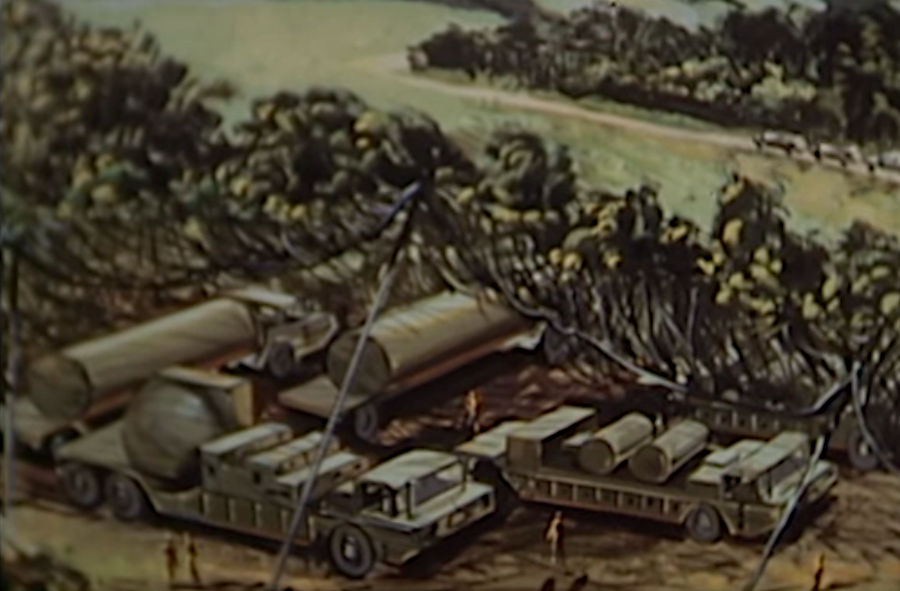
mobile reactors in containment spheres could create synthetic fuels at an energy depot
Source: Army Nuclear Power Program, 1963
The Army Nuclear Power Program built eight military compact reactors that were used at Fort Greely (Alaska), Camp Century (Greenland), and the Panama Canal Zone, plus the US Air Force radar station at Sundance (Wyoming) and the US Navy station at McMurdo Station in Antarctica. Once components were manufactured, they were shipped to the remote location for assembly; with one exception, the other reactors were not built at Fort Belvoir.4
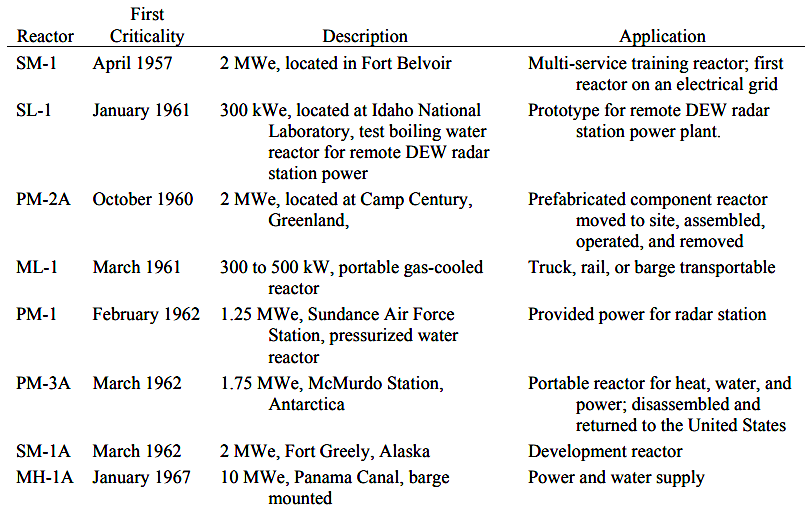
the Army Nuclear Power Program developed eight reactors
Source: Idaho National Laboratory, U.S. Forward Operating Base Applications of Nuclear Power (Table 2)
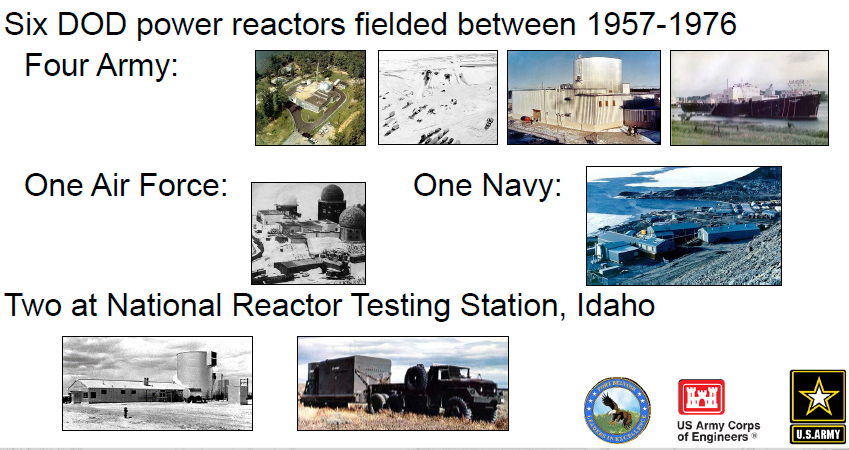
the US Army built nuclear reactors for the US Air Force and the Navy
Source: US Army Corps of Engineers, Public Presentation, March 12, 2019
The reactor operated for 16 years. Though SM-1 was an operating nuclear reactor that supplied electricity to meet some of the military base's demand and a test bed for designing small reactors, it was used primarily as a tool for training.

training included identifying when it might be appropriate to press the red button and immediately scram the reactor
Source: US Army Corps of Engineers, SM-1 Nuclear Power Plant
The Army recruited men with scientific training, then provided by theoretical and hands-on practice at Fort Belvoir. The Army Nuclear Power Program produced 800 nuclear power plant operators who gained experience on SM-1.5
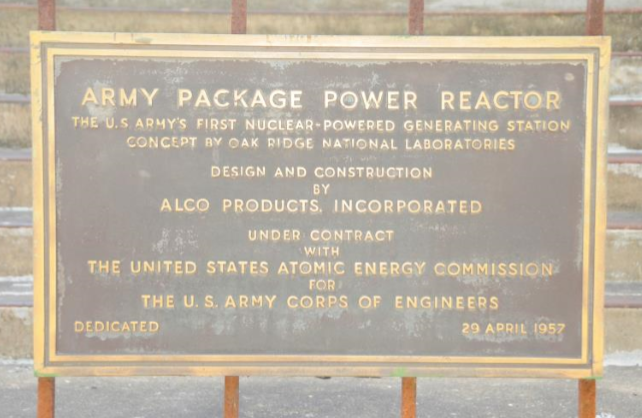
sign on the cinderblock and metal building which housed the SM-1 reactor at Fort Belvoir
Source: US Army Corps of Engineers, SM-1 Deactivated Nuclear Power Plant Decommissioning Project
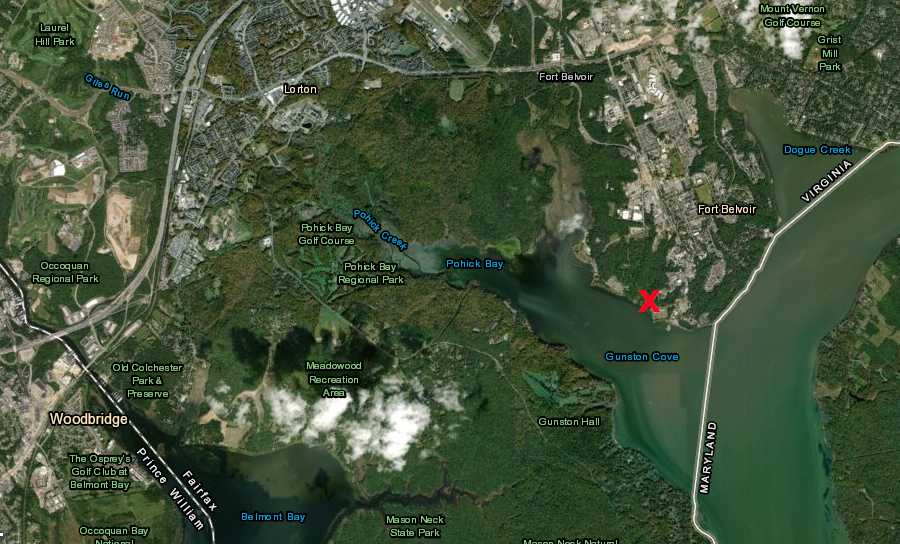
the SM-1 nuclear power plant was built on Gunston Cove, less than 20 miles from downtown Washington, DC
Source: ESRI, ArcGIS Online
The Army's small reactor at the South Pole's McMurdo Station closed in 1972, after 12 years of operation. Its radioactive material was shipped to the United States for burial, and none was left on Antarctica.6
The SM-1 reactor closed in 1973, after 16 years of service:

the small reactors developed in the 1950's and 1960's are no longer operational
Source: US Army Deputy Chief of Staff, Study on the Use of Mobile Nuclear Power Plants for Ground Operations (Table 2-1)
The nuclear reactor at Fort Belvoir was decommissioned as the military redirected funding for long-range projects to deal with the war in Vietnam. In 1977, the fuel rods, control rods, and waste with radioactive material were removed and sent for safe disposal to the Department of Energy's Savannah River Site in South Carolina. The Reactor Containment Vessel was sealed, with the Reactor Pressure Vessel inside. The building with the control room was open briefly as a museum, then closed and left unused for 40 years.
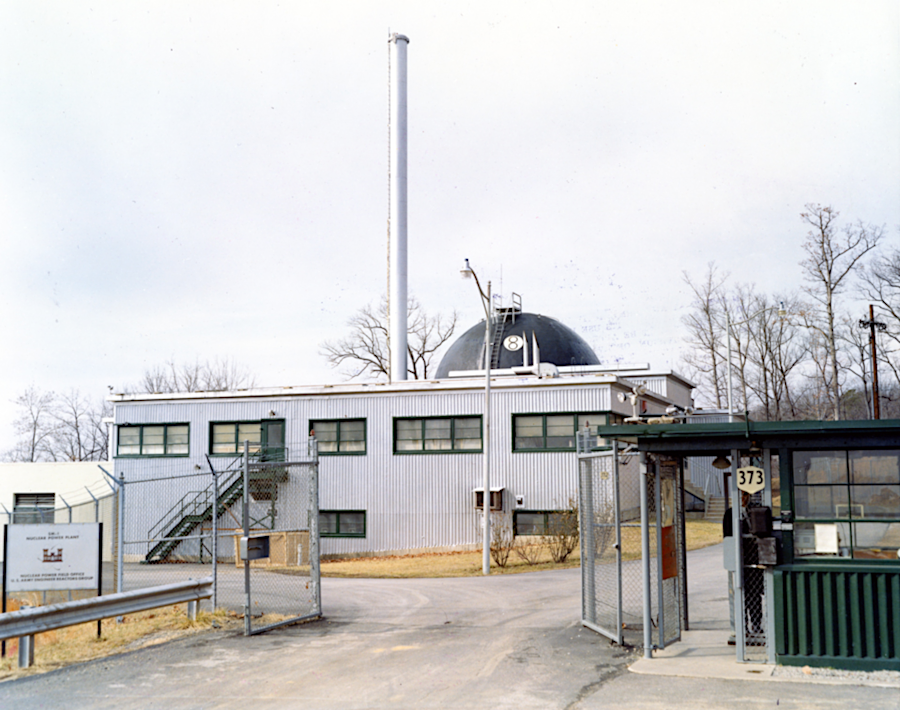
fans of playing pool briefly converted the containment shell into an eight ball
Source: Army Engineer History, Nuclear Power at Fort Belvoir
The site was placed in "safe storage" (SAFSTOR), a custodial status. Decontamination, allowing reuse of the site for unrestricted activities, was deferred while residual radioactivity slowly dissipated.
Though the fuel and radioactive waste had been removed, the metal in the Reactor Pressure Vessel and other components had been activated by neutrons emitted from the fuel rods. Radioactive isotopes of cobalt and nickel were the primary concern in the decommissioning process. Cobalt-60 has a half-life of just 5.7 years, so a 40-year delay allowed a substantial reduction in risk from radiation during final decommissioning.
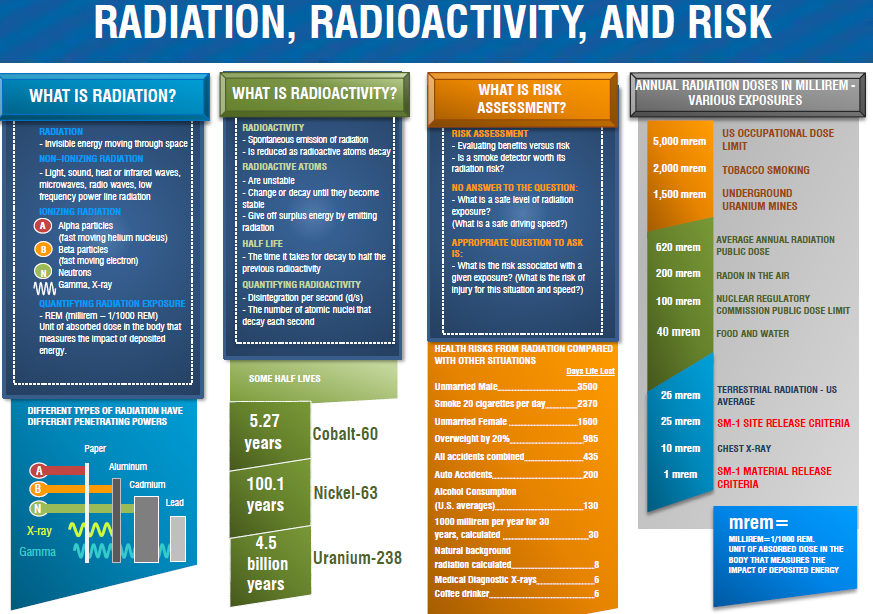
radioactive cobalt at Fort Belvoir has a relatively-short half-life
Source: US Army Corps of Engineers, Draft Environmental Assessment - Public Meeting (January 7, 2020)
The alternatives to SAFSTOR status were complete decontamination (DECON) at the time, or encasing it in concrete (ENTOMB). Placing the site in SAFSTOR required some expense for monitoring, but:7
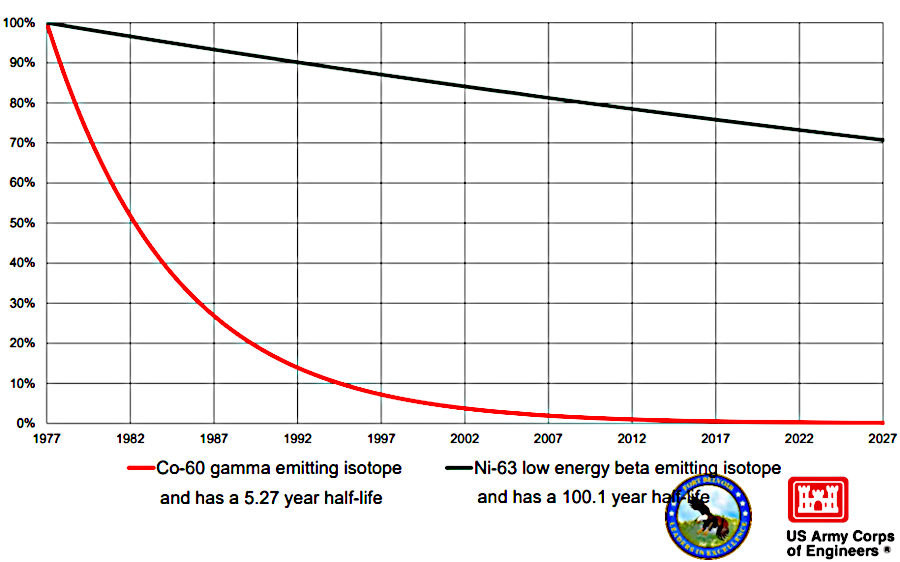
in addition to Co-60 and Ni-63, residual levels of Cs-137 and Sr-90 remained at the site
Source: US Army Corps of Engineers, SM-1 Deactivated Nuclear Power Plant Decommissioning Project
The Nuclear Regulatory Commission regulations require decommissioning a nuclear reactor within 60 years of its final shutdown. In 2019, the Deactivated Nuclear Power Plant Program (DNPPP) in the US Army announced plans to dismantle the remains of Building 372, the structure that had housed SM-1. The 90% of material that was non-radioactive would be treated as standard construction debris and taken to a local construction and demolition debris landfill or recycle facility, of which the closest was in Lorton. The 10% of material that was still radioactive, would be shipped to the Texas Compact Waste Facility in Andrews, Texas, between 2020-2025.
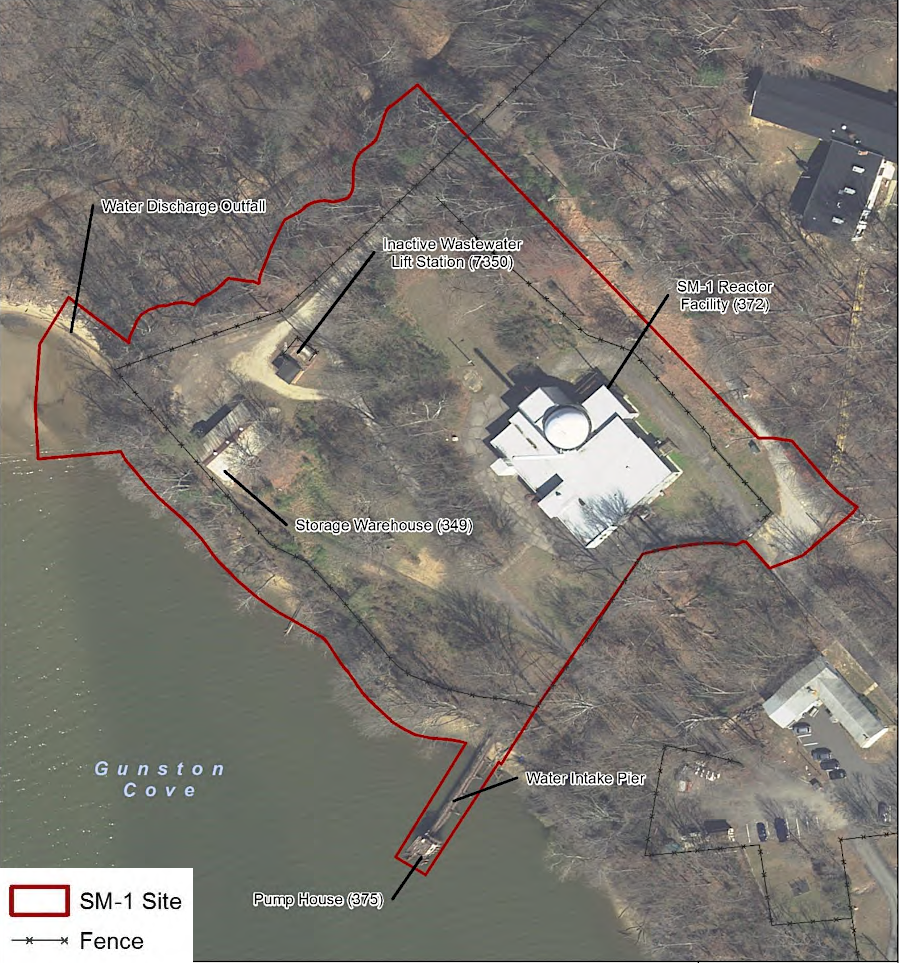
the SM-1 site included the reactor building (Building 372) plus ancillary structures
Source: US Army Corps of Engineers, Deactivated SM-1 Nuclear Reactor Facility Decommissioning and Dismantlement Draft Environmental Assessment - Vol. I (Figure 1.2‐3: SM‐1 Site)
The Reactor Pressure Vessel (RPV) had been sealed and left at the Fort Belvoir site when the reactor was decommissioned. The contract proposal for final removal of the 16-ton pressure vessel and its 30-ton shield rings highlighted the need for special planning and engineering, starting with removal of the osprey nest on the Vapor Container stack.
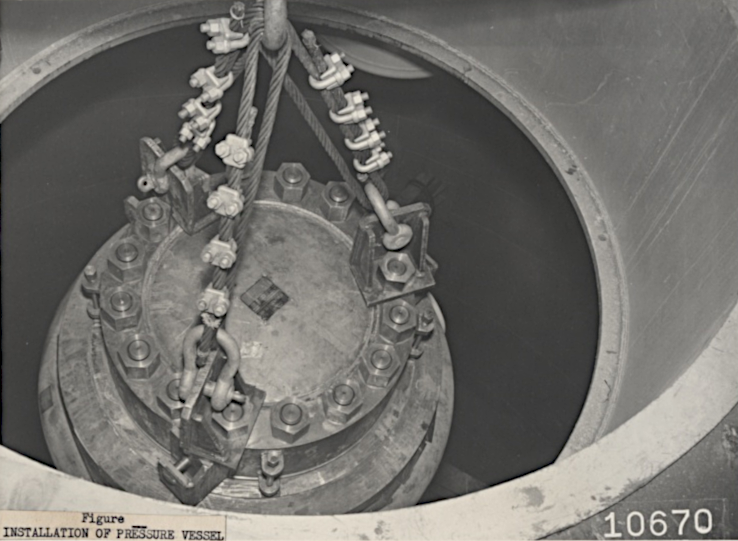
the Reactor Pressure Vessel (RPV) being installed originally in the SM-1 reactor in 1957
Source: US Army Corps of Engineers, Deactivated SM-1, Former Nuclear Power Plant
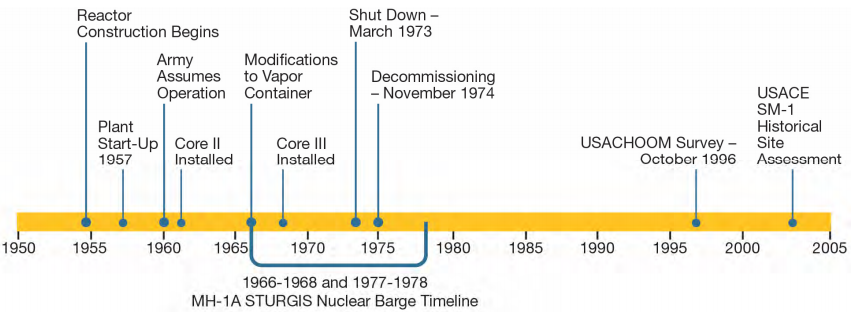
timeline for SM-1 reactor installation and decommissioning
Source: US Army Corps of Engineers, Deactivated SM-1 Nuclear Reactor Facility Decommissioning and Dismantlement Draft Environmental Assessment - Vol. I (Figure 1-3.1)
The ancillary structures, including the pier extending 100 feet into Gunston Cove, would be removed first. To minimize both cost and disturbance of sediments, the pilings for the pier would be cut at the mudline rather than pulled up. Approximately 70 tons of material, including foundations and footings that extended to 18 feet below ground surface, would be treated as Class A waste.
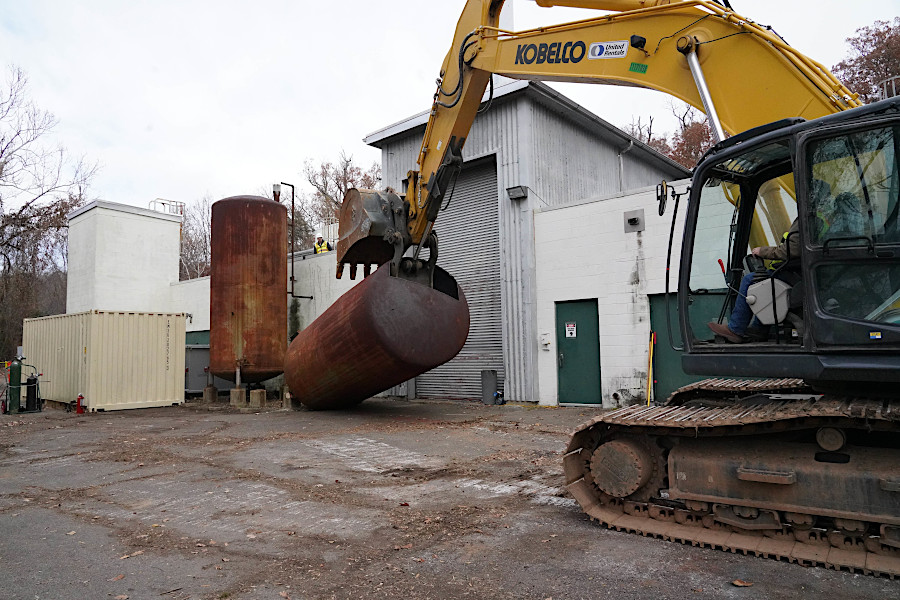
removal of aboveground storage tanks and other equipment began in November, 2021
Source: US Army Corps of Engineers, SM-1: December 7, 2021 Stakeholder Update
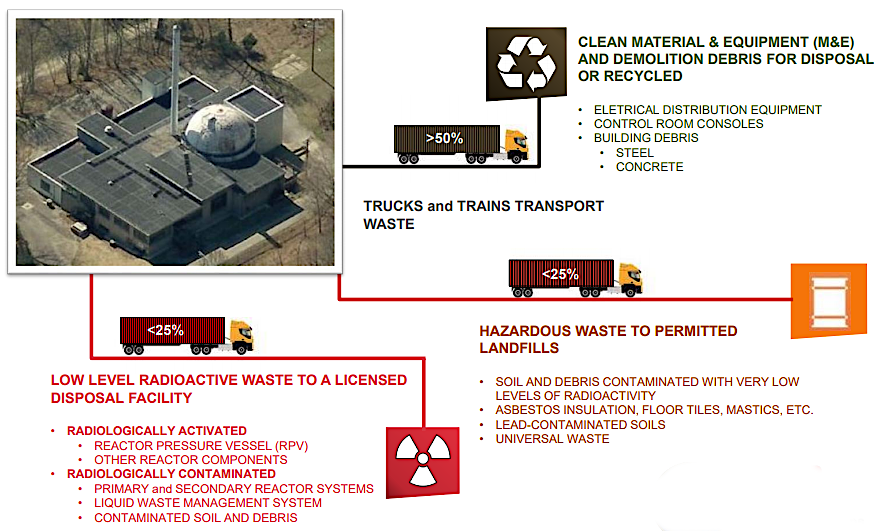
final cleanup in 2020-25 required waste to be segregated by risk, then carried to different landfills
Source: US Army Corps of Engineers, SM-1 Deactivated Nuclear Power Plant Decommissioning Project
Trucking to local, or to regional truck‐to‐rail transfer locations for shipping to the ultimate disposal facility, was proposed. Though the reactor site at Fort Belvoir was on the river shoreline, barge access would require substantial dredging of Gunston Cove.
The Reactor Pressure Vessel (RPV) was shipped in one piece as Class B low-level radioactive waste. The load transporting the vessel, when placed in a primary shield tank and then a shipping cask, was predicted to weigh 60,000 to 80,000 pounds. The contractor was responsible for:8
Source: US Army Corps of Engineers, SM 1 Decommissioning & Dismantlement Begins
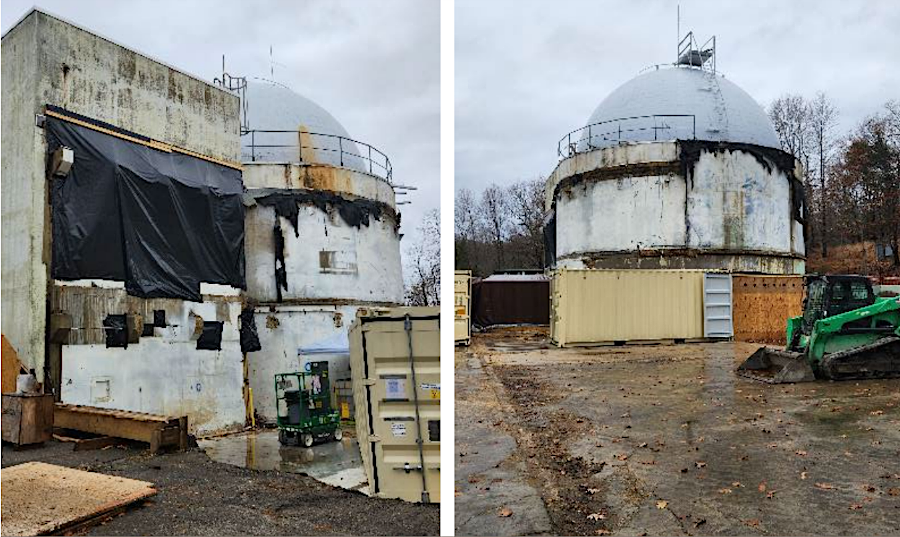
by the end of 2022, only the Vapor Container and the Spent Fuel Pit remained to be demolished
Source: US Army Corps of Engineers, SM-1 Fort Belvoir Decommissioning
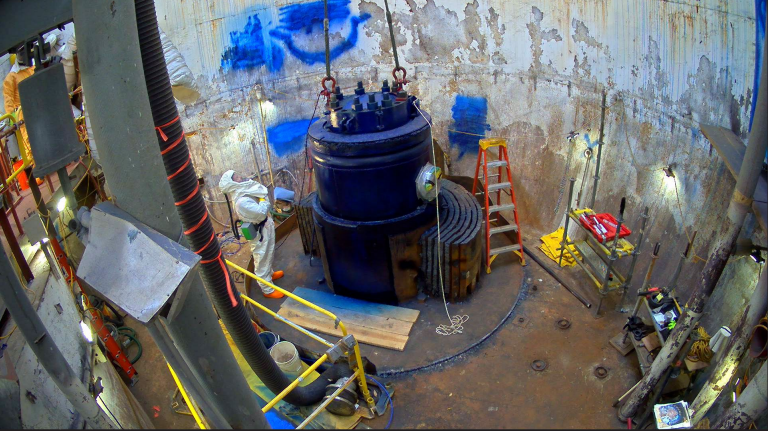
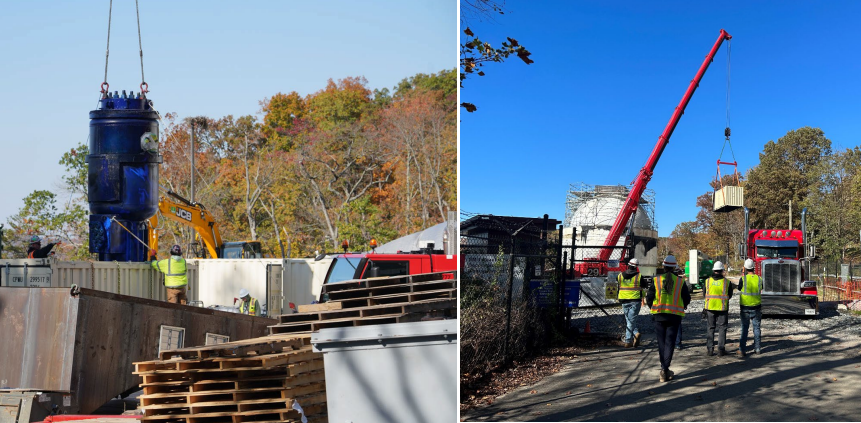
the Reactor Pressure Vessel was removed and transported in November 2023 to Andrews County, Texas for permanent disposal
Source: US Army Corps of Engineers, SM1 Stakeholder Update: November 2023
In 2020, the U.S. Army Corps of Engineers awarded a $68 million contract for the "decommissioning, dismantling and disposal of the deactivated SM-1 nuclear power plant." By the end of 2022, only the Vapor Container and the Spent Fuel Pit remained to be demolished.
In late 2023, the Reactor Pressure Vessel was removed and transported to the Federal Waste Cell at the WCS facility in Andrews County, Texas. In 2025, the last pieces to be removed were the building slab and underground components.9
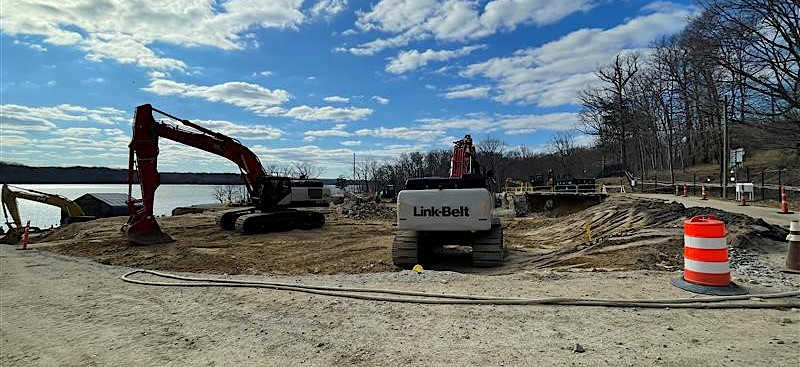
only the underground components remained to be removed in 2025
Source: US Army Corps of Engineers, SM-1 Stakeholder Update: 3 April 2025
The site of the SM-1 reactor was historic, but it was also near the classified night vision operations and not suitable for general public use at the time. The option of creating another museum was rejected, but the Draft Environmental Assessment (EA) in 2019 proposed a cleanup so thorough the site could be released for unrestricted use. The goal was based on the Nuclear Regulatory Commission's radiological dose criteria:10
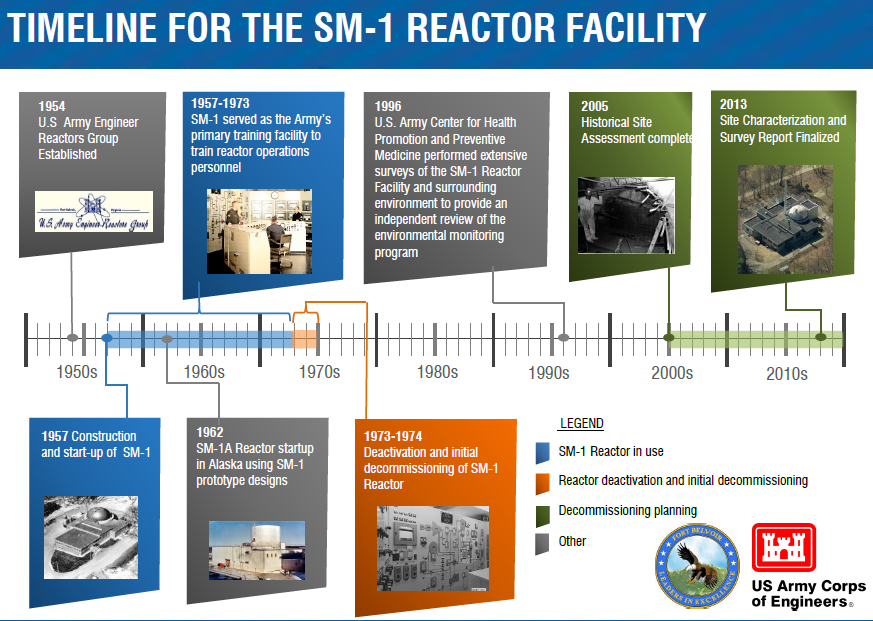
from initial planning to initial deactivation, the SM-1 reactor project lasted 20 years - and final cleanup required another 50 years
Source: US Army Corps of Engineers, Public Presentation Posters, March 12, 2019
In 1992, the Army Nuclear Power Program (ANPP) became the Army Reactor Office (ARO), part of the U.S. Army Nuclear and Countering Weapons of Mass Destruction Agency (USANCA). The vision of battlefield power from nuclear reactors, initially tested at Fort Belvoir, is still alive. The dream is for reactors to provide electricity at isolated facilities, without requiring petroleum to be trucked through unsecure areas to power diesel generators.
The Department of Defense still anticipates that small (1MW-10MW) nuclear reactors can be manufactured in portable modules and brought to forward remote operating bases. The Strategic Capabilities Office issued a Request for Information for a Small Mobile Nuclear Reactor in January, 2019. The reactors would be transportable by truck, ship, and C-17 aircraft, and could go into operation within 72 hours of arrival on site.
Half of the casualties from the war in Iraq occurred during transport of supplies, especially diesel. The commander of the 1st Marine Division during the 2003 invasion of Iraq identified a clear solution:11
The potential of using a small modular reactor to generate electricity for military bases in Virginia was still being explored 60 years after SM-1 was developed. A base could create a mini-grid and, with local generation capability, maintain operational capability during a blackout or if the main transmission lines to the site were destroyed by terrorist attack.
Oak Ridge National Laboratory assessed eleven potential sites in Hampton Roads in 2014. That study concluded that a small modular reactor built on a 40-acre parcel would be suitable at the Surry Power Station, Camp Peary, and the Yorktown Weapons Station.12

11 places in Hampton Roads were evaluated in 2014 for the potential for deploying small reactors
Source: Oak Ridge National Laboratory, Population Sensitivity Evaluation of Two Candidate Locations for Possible Small Modular Reactor Siting (Figure ES-3)
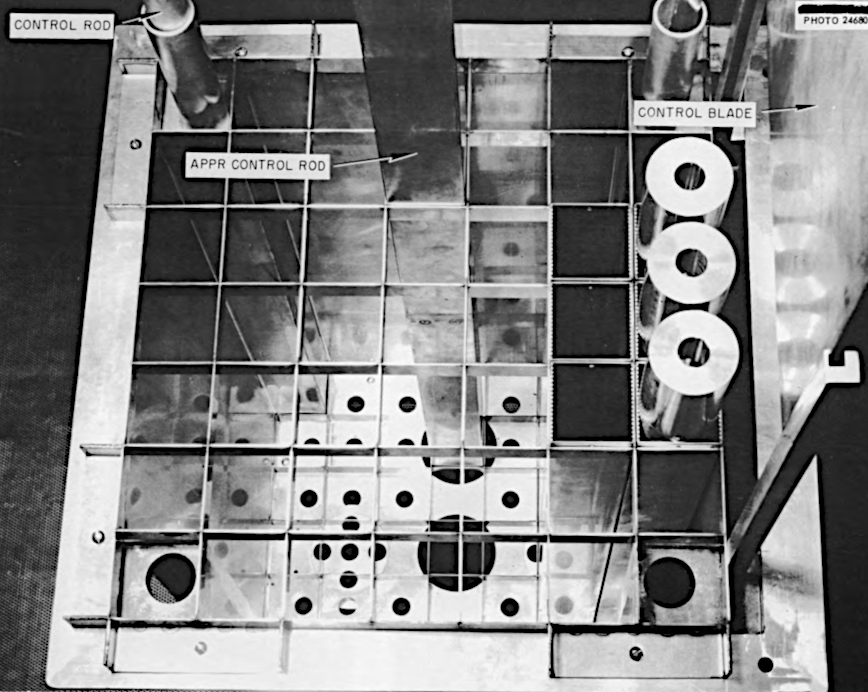
the design of fuel and control roads was tested first at Oak Ridge National Laboratory, before construction of SM-1
Source: U.S. Department of Energy, Office of Scientific and Technical Information, Army Package Power Reactor, Critical Experiment (Figure 3)
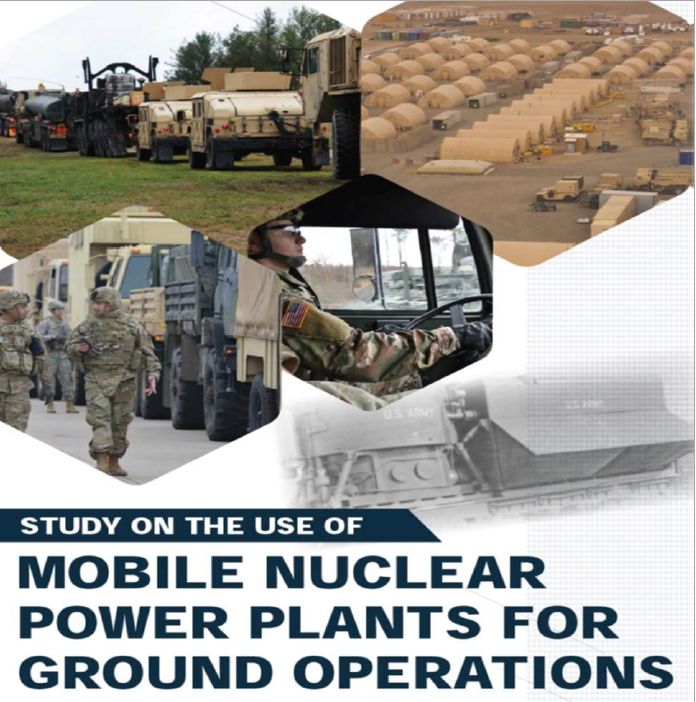
the Department of Defense is actively researching the potential for deploying small reactors
Source: US Army Deputy Chief of Staff, Study on the Use of Mobile Nuclear Power Plants for Ground Operations
Source: US Army Corps of Engineers, SM-1 Nuclear Power Plant
Source: US Army Corps of Engineers, SM 1 Demolition, Fall 2022
Source: US Army Corps of Engineers, SM-1 Vapor Container Hatch Removal
Source: US Army Corps of Engineers, Removal of Large Components from SM-1's Vapor Container
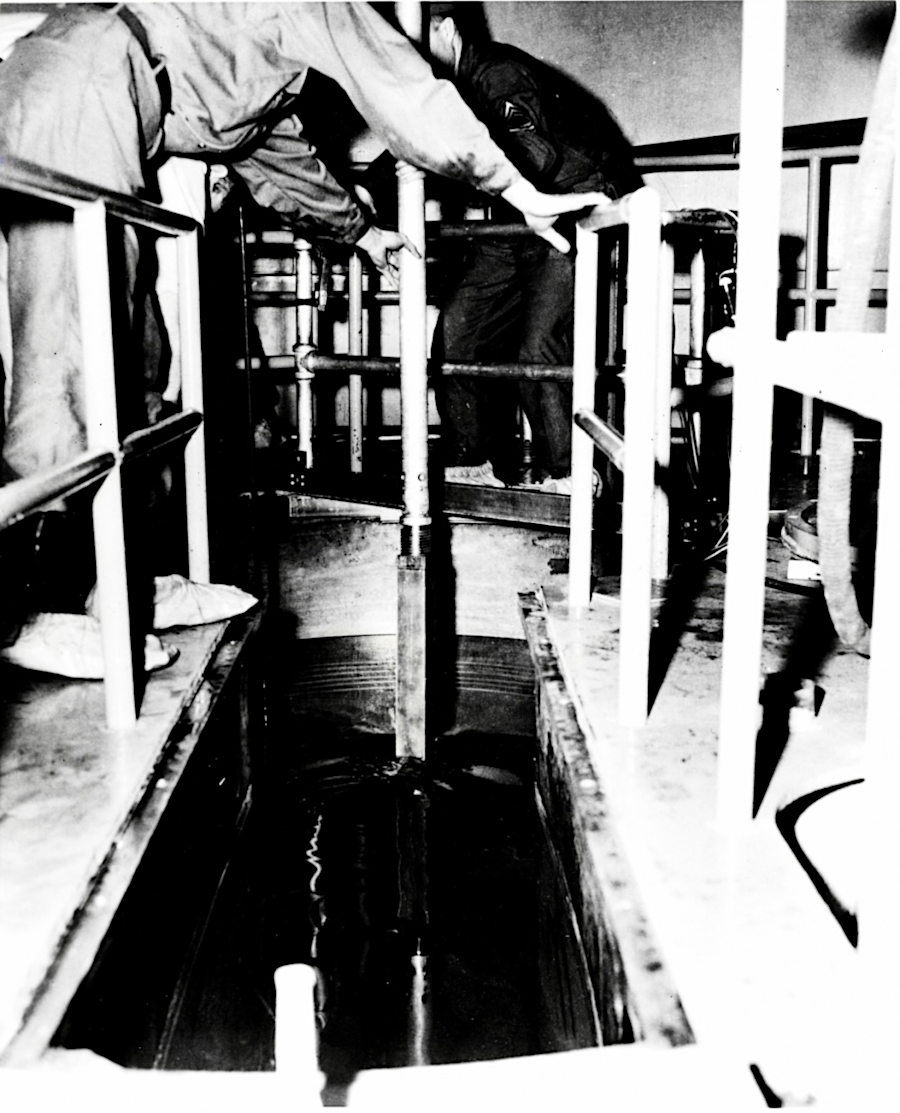
the first fuel rods loaded into Virginia's first reactor core through a water shield were non-radioactive "dummies," to test the procedure
Source: US Army Corps of Engineers, Deactivated SM-1, Former Nuclear Power Plant (Image 11 of 12)
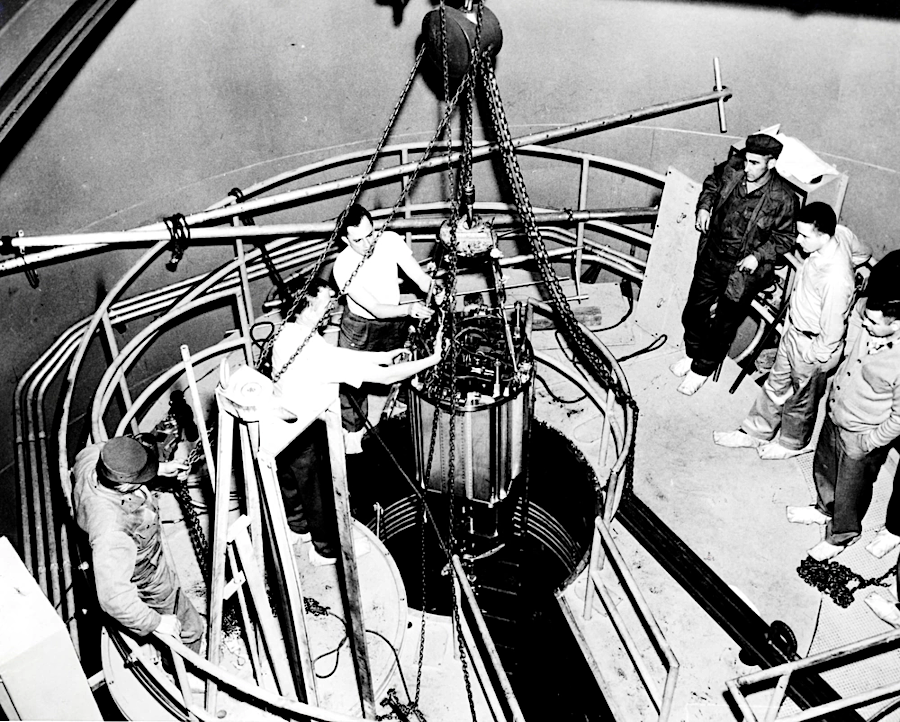
the US Army installed a nuclear reactor in a shielded building at Fort Belvoir in the 1950's
Source: You-Tube video, Media Gallery: SM-1 Photos and B-Roll
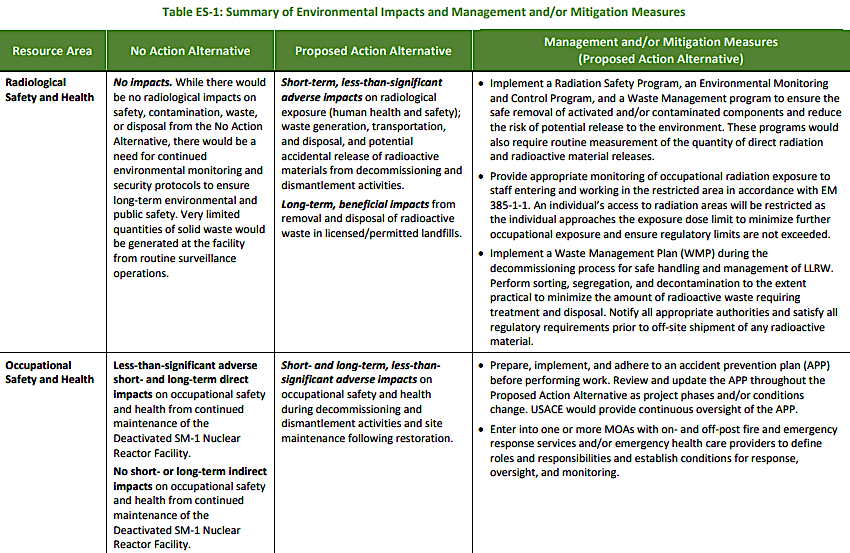
the 2019 Environmental Analysis assessed No Action and Preferred Action alternatives
Source: US Army Corps of Engineers, Deactivated SM-1 Nuclear Reactor Facility Decommissioning and Dismantlement Draft Environmental Assessment - Vol. I